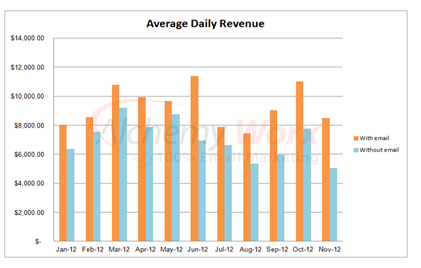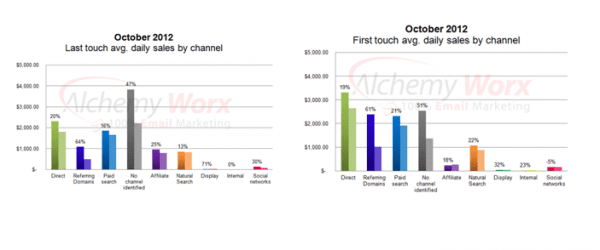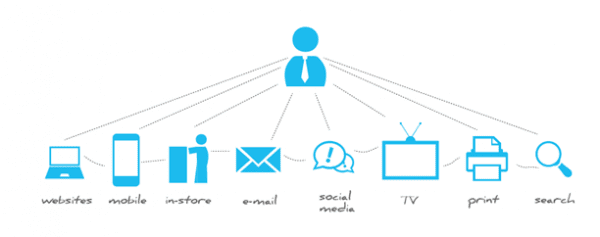Research examples of measuring email marketing effectiveness using attribution
Sometimes email is a victim of its own success. It works so well to drive revenue across all channels but this cross channel revenue is rarely calculated accurately and attributed to email.
Why is this? Possible because email is the cheapest of the channels and it is shown to work without having to pull together all possible revenue. Basic stats prove email works. However, every channel is competing for budget and has to be seen to improving over time so maybe it is time email got its fair share of the pie. An unpublished study by Alchemy Worx for one of their clients over a 10 month period to monitor revenue on days with and without sending any emails.

The charts shown in this article and all the data behind it is taken from analysis of client data conducted by Alchemy Worx Ltd and MineThatData
The graph shows the revenue across all channels except email. If email wasn’t driving revenue across other channels then the blue and orange bars would be equal. Instead, on days with email, the average is an increase of 21.5%.
For further insight they also looked at how much email drove each individual channel using both first and last touch attribution. The bar on the left shows revenue with email.

The question is why is it so difficult to accurately apportion attribution?
It's a simple model, tracking email attribution is easy. A recipient clicks on a link in an email which takes them to your website and they complete a purchase. In this case email is the first and last touch point. In reality it very often doesn’t work like this.
Someone sees an ad in a magazine and then does a search online to find your website and get distracted or they have no immediate need. At some point in the future they receive an email from you and they click on a link or file it 'for future reference' or maybe forward to a friend/colleague who might be interested. The friend is then walking down the street and see’s the product in a window. Remembers the email forwarded and goes into the shop to purchase. Get more info via reviews and then purchase. You get the idea.

The whole process from first touch point to purchase is called a 'conversion funnel' and in theory every element within the funnel should be attributed some revenue from the sale.
In the example, email using a first or last touch point model email would get no credit. Often a timely email serves as a 'memory jogger]. Another channel has sown the seed, email reminds you and another channel completes the deal. Email drives other channels.
Marketing channels interaction and measurement is like a football team!
It helps to think as all of your marketing channels as a football team (soccer team for those in the US). The aim of the team is for the football team to score a goal. The aim of your marketing channels is to generate revenue. Each pass is a customer’s interaction with a channel. If the other side get the ball then you can see that as an interaction with competitor’s channels. The build-up play to a goal might include many passes before the final goal.
The difference between a football team and marketing channels is that you don't have any defensive marketing channels. That is, channels that are their not to score goals but prevent the opposition scoring goals. Your goalkeeper and defenders are often the unsung heroes of any good football team. Maybe I could stretch the analogy slightly and say that your back four and goal keeper are fulfilment, customer service, support and other like channels.
They support the 'forward' six channels and occasionally make a key pass (support directs an existing client to your website to order more licenses) but generally they just make everything work in the background.
Email is the attacking midfielder that every great team has. It often makes key passes to other channels and scores many of its own goals. Channel attribution is all about working out how much each player contributed to a goal and then their total contribution over a season. At the end of the season you can sell players that aren't contributing and invest the money in channels that work.
In football, TV broadcasters have every possible stat you would ever need about your players. Goals scored, passes completed, tackles made, incomplete passes, key passes etc. With all these stats you can put together a pretty accurate score for each player for their contribution over a season.
In marketing all channels aren't recorded and interconnected and there is no time limit. An email campaign may lead someone to search for product they saw in an email. If they purchase from the search then search will show as scoring the goal, and emails' 30 yard pass to search will go unrecognised.
An email you receive today might lead you to purchase tomorrow, next week, next month or next year. .
So how do you fairly attribute revenue to email?
Obviously a model to fairly attribute a percentage of each sale to each channel it going to be very complex and often not worth the effort. At the other end of the spectrum, last click attribution only ever gives credit to your goal scorers and your players that run around tirelessly providing the passes for these goals never get a mention. Can you imagine what would happen if this really happened in football.
The only true way to find your email attribution is to stop emailing. Ok. So you probably don’t want to stop emailing everybody so you need to create a sample group. A good cross section. Monitor their activity during email periods and then stop emailing them for a period and compare the results. Or as in the Alchemy Worx example, look at days when you sent campaigns and didn’t send campaigns and revenue generated.
With a bit of data knowledge you can cross references sales with your email logs and see when people received emails. Anything within a 24 hr period should give some credit to email but then depends on what else is happening at the time
At the end of the day everyone is playing on the same team and a win is a win. Who scores the goals or makes the key contributions is irrelevant until it comes to the end of the season. There is only a finite amount of budget available and those players not pulling their weight will be sold. Equally marketing budgets get redistributed and those channels not performing will see budgets cut and those over performing will get more cash. It’s at the end of the season when attribution counts.

Thanks to
Simon Hill for sharing his advice and opinions in this post. Simon is a co-founder of
Extravision, an Email Marketing Agency based in Manchester with their own email delivery platform as well as partnering with other leading ESP’s to offer their clients the solution that best fits their needs. He is a member of the DMA Email Council and Email Best Practice hub and has been involved in email marketing for over 10 yrs. You can follow him on
Twitter or connect on
LinkedIn.





 Thanks to
Thanks to 

